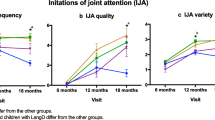Abstract
Infants’ abilities to focus attention on objects are known to be related to mothers’ mobilizing behaviors. As delayed effects of maternal behaviors at 5 months may be observed in 8-month-olds, mothers may be considered as scaffolding their infant’s attention. However, all dyadic activities are probably not equally propitious to attention mobilizing. In a sample of 30 dyads, studied at 5 and 8 months of age, whole observations were split in four broad categories: care, dyadic play with objects, dyadic play without objects and infant alone. The duration of maternal mobilizing and infant attention focussing were studied within categories. Inter-dyads variability is high, while dyads are stable across ages. Even within the dyadic play with objects, mothers differ widely in the duration and way they mobilize attention. Five-month-olds still need their mother’s support, as they explore less when they are alone, while 8-month-olds are more autonomous. The impact and importance of the various types of dyadic activities on cognitive development are discussed.
Similar content being viewed by others
References
Ainsworth, M. D. S., Blehar, M. C., Waters, E., & Walls, S. (1978).Patterns of attachment: a psychological study of the strange situation. Hillsdale, NJ: Erlbaum.
Bakeman, R. & Adamson, L. B. (1984). Coordinating attention to people and objects in mother-infant and peer-infant interaction.Child Development, 55, 1278–1289.
Belsky, J., Goode, M. K., & Most, R. K. (1980). Maternal stimulation and infant exploratory competence: correlational and experimental analyses.Child Development, 51, 1163–1178.
Bornstein, M. H. (Ed.) (1989a).Maternal responsiveness: characteristics and consequences. San Francisco: Jossey Bass.
Bornstein, M. H. (1989b) Between caretakers and their young: two modes of interaction and their consequences for cognitive growth. In M. H. Bornstein, & J. S. Bruner (Eds.).Interaction in human development, (pp. 197–214). Hillsdale, NJ: Erlbaum.
Brody, S. (1956).Patterns of mothering. New York: International Universities Press.
Cohen, J. (1960). A coefficient of agreement for nominal scales.Educational and psychological measurement, 20, 37–46.
Gottfried, A. W. (Ed.) (1984).Home environment and early cognitive development. New York: Academic Press.
Heckhausen, J. (1987). Balancing for weaknesses and challenging developmental potential: a longitudinal study of motherinfant dyads in apprenticeship interactions.Developmental Psychology, 23, 762–770.
Lamb, M. E., & Easterbrooks, M. A. (1981). Individual differences in parental sensitivity: some thoughts about origins, components, and consequences. In M. E. Lamb & L. R. Sherrod (Eds.),Infant social cognition: empirical and theoretical considerations (pp. 127–153) Hillsdale, NJ: Erlbaum.
Lécuyer, R. (1989).Bébés astronomes, bébés psychologues: l’intelligence de la première année. Bruxelles: Mardaga.
Levis, M., & Feinman, S. (Eds.) (1990).Social influences and socialization in infancy. New York: Plenum Press.
Papousek, H., & Papousek, M. (1989). Intuitive parenting: aspects related to educational psychology.European Journal of Psychology of Education, 4, 201–210.
Pêcheux, M.-G. (1990). L’ajustement parental: un concept à la fois utile et flou.L’Année Psychologique, 90, 567–583.
Pêcheux, M.-G., Findji, F., & Ruel, J. (1992). Maternal scaffolding of attention between 5 and 8 months.European Journal of Psychology of Education, 7, 209–218.
Riksen-Walraven, M. (1978). Effects of caregiver behavior on habituation rate and self-efficacy in infants.International Journal of Behavioral Development, 1, 105–130.
Wachs, T. D., & Gruen, G. (1982).Early experience and human development. New York: Plenum.
Author information
Authors and Affiliations
Additional information
The research was partly supported by a grant from Inserm (n°. 859012)
Rights and permissions
About this article
Cite this article
Findji, F., Pêcheux, MG. & Ruel, J. Dyadic activities and attention in the infant: A developmental study. Eur J Psychol Educ 8, 23–33 (1993). https://doi.org/10.1007/BF03172861
Received:
Revised:
Issue Date:
DOI: https://doi.org/10.1007/BF03172861




